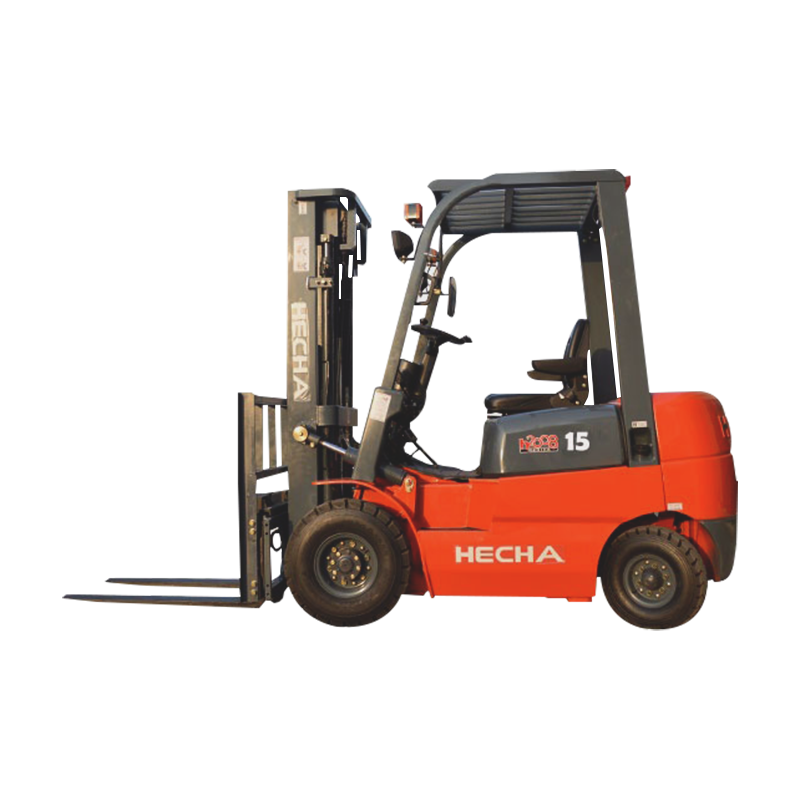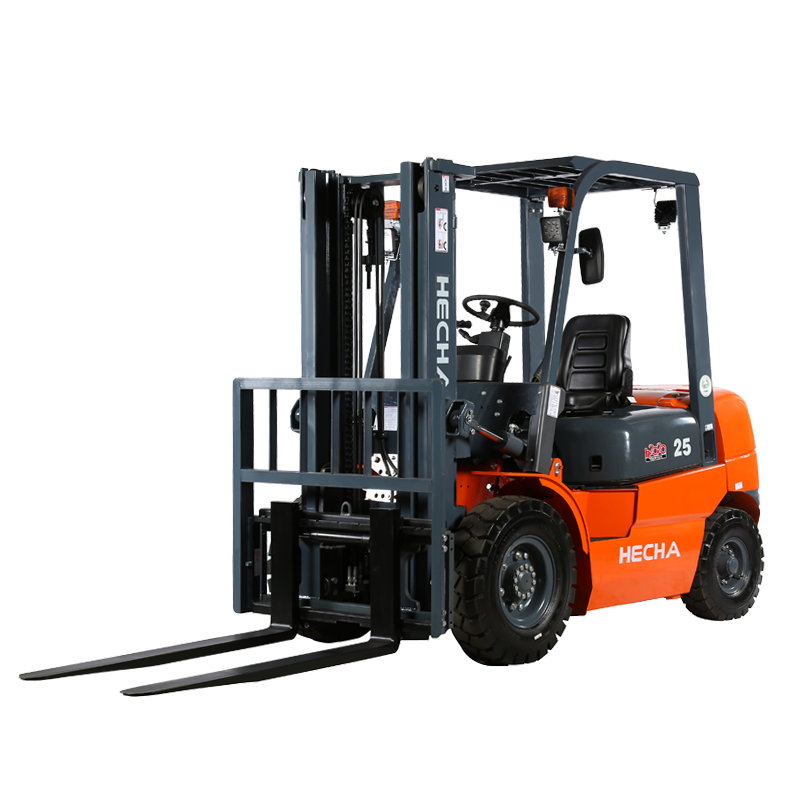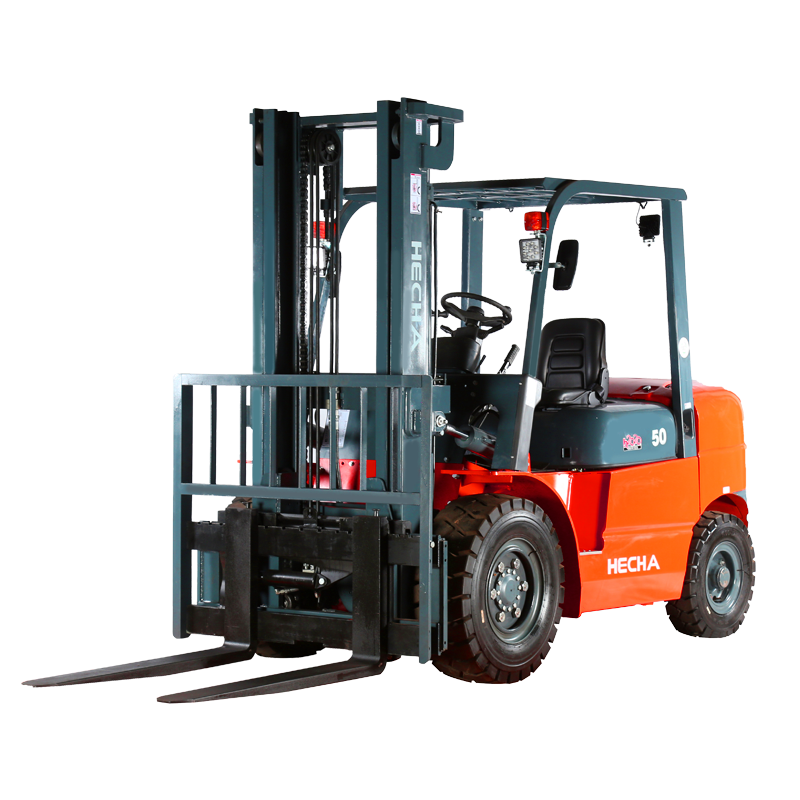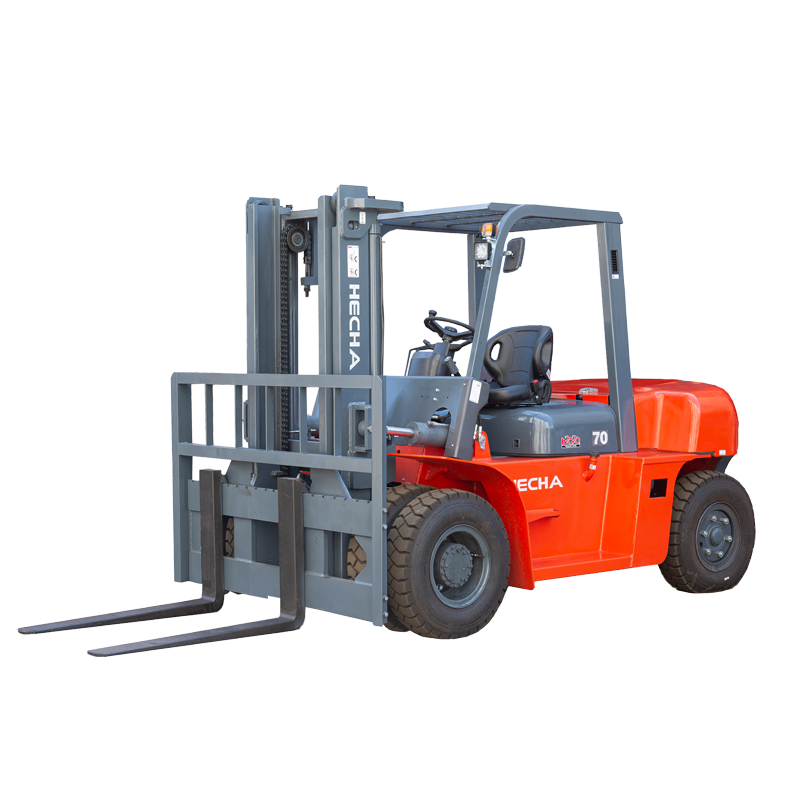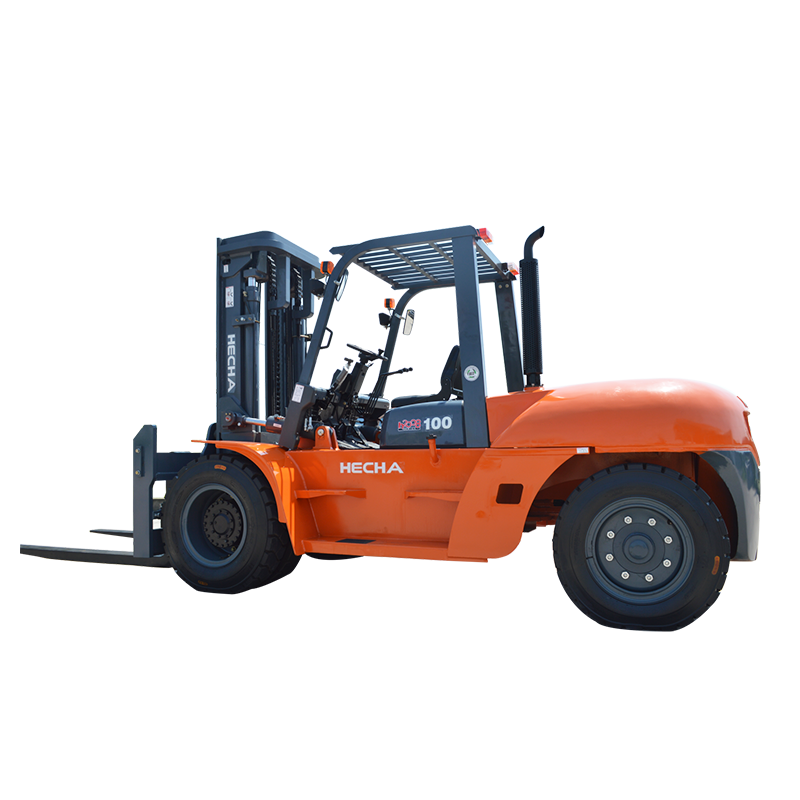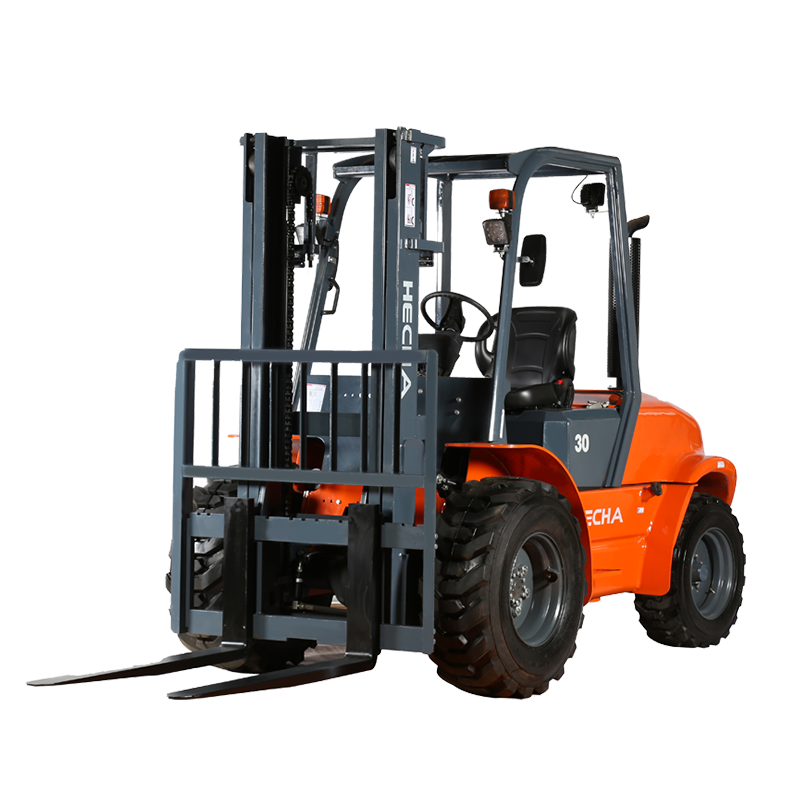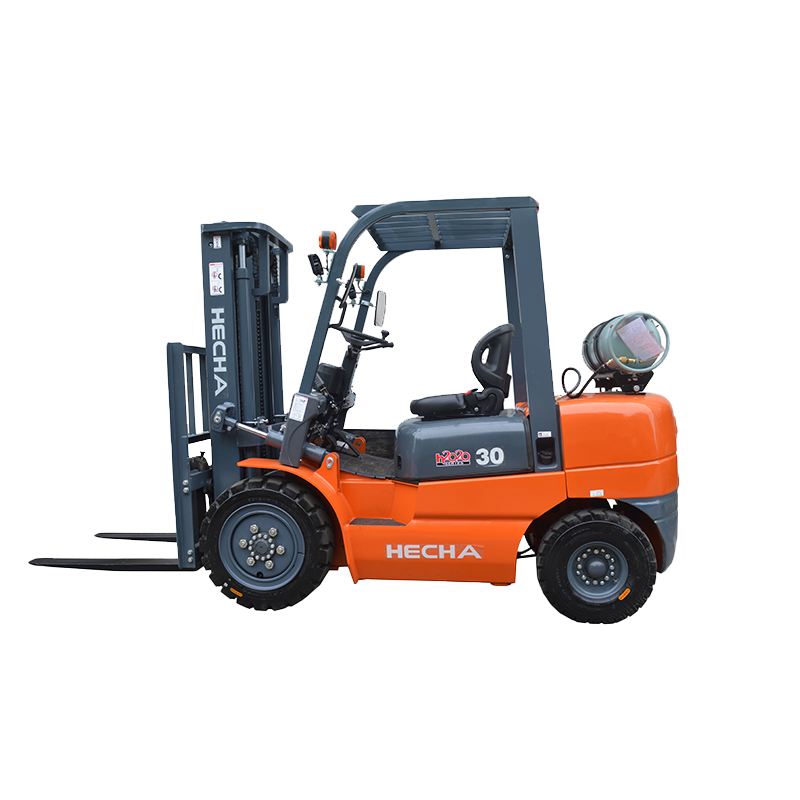What is a manual pallet stacker?
Manual pallet stackers refer to various wheeled transport vehicles that load, unload, stack, and transport palletized goods over short distances. The International Organization for Standardization ISO/TC110 classifies them as industrial vehicles. They have a relatively simple structure and are mainly operated by manpower. They are flexible to operate and have good micro-mobility. They are especially suitable for operation in narrow passages and limited spaces. They are ideal equipment for loading and unloading palletized goods in high-bay warehouses and workshops.
Operating principle of manual pallet stacker
Manual pallet stacker usually consists of three parts: hydraulic system, mast and fork. The manual hydraulic jack is used as the power to lift the heavy objects, and the operation of carrying heavy objects is realized by pushing and pulling by manpower. The hydraulic device is equipped with an oil return valve, and the descending speed of the fork can be controlled by the handle to ensure that the hydraulic system operates correctly, safely and reliably. For example, when it is necessary to lift the goods, the operator inserts the fork under the cargo pallet, brakes the rear wheel if necessary, and then pulls the handle. At this time, the pressure wheel presses the pump core, so that the oil in the pump cylinder enters the piston cylinder, pushes the piston rod upward, and drives the fork upward through the chain, which can generally achieve a double stroke lift. By pulling the handle back and forth, the goods can be continuously lifted to achieve the purpose of lifting. When the fork rises to the highest position, the pressure oil flows back to the oil tank through the oil drain hole. Even if the handle continues to be pulled, the fork will no longer rise, thereby avoiding damage to the machine parts due to top impact. When carrying heavy objects, the operator pushes (pulls) the stacker by manpower. When unloading, pull the unloading handle and the oil return valve will open. Under the action of the weight of the heavy object and the fork, the working oil in the piston cylinder returns to the oil tank through the oil return valve. The piston rod and the fork drop to the lowest position, and the heavy object can be unloaded and the fork can be pulled out.
Classification system of manual pallet stackers
1. Classification by mast structure
l Single-gantry manual stacker : The single-gantry structure design makes its turning radius small, suitable for working environments with relatively narrow space, such as machinery manufacturing, papermaking, printing, handling, logistics and other industries. Its gantry usually adopts heavy-duty "C"-shaped steel columns, which are formed by cold bending and have strong firmness and safety.
l Double-gantry manual stacker : Compared with a single-gantry structure, the double-gantry structure provides higher stability and can carry heavier goods. It is suitable for operating scenarios with high requirements on cargo weight and stability, such as cargo stacking in large warehouses.
2. Classification by operation method
l Fully manual stacker : From lifting, transporting to stacking, the entire process is completely manual. This type of stacker has the simplest structure and low cost, but the labor intensity is relatively high. It is suitable for places with small cargo handling volume and low operation frequency.
l Manual-foot-operated interchangeable stacker : In addition to the traditional manual lever operation, foot-operated operation has been added to improve the flexibility and convenience of operation. Operators can choose the operation method that suits them best according to the actual operation situation, which reduces labor intensity to a certain extent.
Distinctive features of manual pallet stacker
1. Simple structure
The structure of manual pallet stacker is relatively simple, without complicated electrical and automatic control systems, and mainly consists of basic mechanical parts. This makes its manufacturing cost low, and it is also convenient for daily maintenance and maintenance, reducing the cost of use.
2. Flexible control
Due to its small size and the universal wheel design, the manual pallet stacker can move freely and flexibly in narrow passages and limited spaces. The operator can easily control its driving direction and position to accurately transport the goods to the designated location.
3. Good micro-motion
Manual pallet stackers can achieve precise micro-motion control when stacking and loading and unloading goods. The operator can accurately adjust the height and position of the fork through subtle operating movements to ensure that the goods are placed in the target position steadily and accurately to avoid damage to the goods.
4. High explosion-proof safety performance
Manual pallet stackers do not rely on electric drive, and there is no risk of explosion caused by electrical sparks. Therefore, they are particularly suitable for places with fire and explosion protection requirements, such as petroleum, chemical, pharmaceutical, paint, pigment and other industries, as well as ports, railways, freight yards, warehouses and other places containing explosive mixtures. In addition, its hydraulic system is usually specially designed with good sealing performance and safety protection devices, which further improves the safety of the operation.
5. Economical and practical
Manual pallet stackers are relatively affordable and are an economical and practical choice for companies with limited funds but material handling needs. At the same time, they do not require additional energy consumption and only require manual operation, so the operating cost is low. Moreover, due to its simple structure and easy operation, it does not require high skills for operators, and can be operated without complex training, reducing labor costs.
Manual pallet stacker industry
1. Manufacturing
In various manufacturing enterprises such as machinery manufacturing, automobile manufacturing, and electronic manufacturing, manual pallet stackers are widely used in the transportation of raw materials, the turnover of semi-finished products, and the warehousing of finished products. For example, in a machinery manufacturing workshop, workers can use manual pallet stackers to move the parts needed for production to the production line for easy access at any time; in an electronic manufacturing factory, manual pallet stackers can be used to move assembled electronic products to the warehouse for storage.
2. Warehousing and logistics
Warehouses and logistics centers are one of the main application places for manual pallet stackers. It can help workers efficiently load, unload, stack and transport goods over short distances, and improve the utilization rate of storage space. Whether it is a large logistics hub or a small storage warehouse, the manual pallet stacker can play its flexible and convenient advantages to quickly complete the operation of goods in and out of the warehouse.
3. Printing industry
Printing workshops usually have high requirements for fire and explosion prevention. Manual pallet stackers are an ideal choice for material handling in the printing industry due to their good explosion-proof performance. They can be used to transport printing materials such as paper, ink, and printing plates, as well as to transport printed products to designated areas for sorting and packaging.
4. Pharmaceutical Chemicals
The pharmaceutical and chemical industries have extremely strict requirements on the safety of the production environment. Manual pallet stackers are widely used in these two industries. They can safely transport various pharmaceutical raw materials, chemical reagents and finished products while meeting explosion-proof safety standards, avoiding potential safety hazards caused by electrical equipment.
5. Ports and terminals
At the port terminal, the manual pallet stacker can be used for loading and unloading of cargo, as well as for stacking and handling of cargo in the terminal warehouse. It can be flexibly operated in a more complex port operating environment, and cooperate with other large loading and unloading equipment to improve the loading and unloading efficiency of cargo.
Production process of manual pallet stacker
1. Raw materials procurement
The main raw materials required for the production of manual pallet stackers include steel, hydraulic components, wheels, handles, etc. Steel is usually made of high-quality steel and plates to ensure the structural strength and stability of the stacker. Hydraulic components need to be purchased with reliable quality and stable performance, such as hydraulic cylinders, oil pumps, valves, etc., to ensure the normal operation of the hydraulic system. Wheels are generally made of wear-resistant and pressure-resistant rubber wheels or nylon wheels, and handles are required to have a good grip and comfortable operation.
2. Parts Processing
l Steel processing : The purchased steel is processed through cutting, welding, bending, drilling and other processing procedures to make various parts such as portals, frames, forks, etc. During the processing, it is necessary to strictly control the dimensional accuracy and welding quality to ensure that the quality of the parts meets the design requirements. For example, the welding of the portal requires the use of professional welding technology to ensure that the weld is firm and smooth, without defects such as false welding and leaking welding, so as to ensure the strength and stability of the portal.
l Hydraulic component assembly : Assemble the purchased hydraulic cylinders, oil pumps, valves and other components to form a complete hydraulic system. During the assembly process, installation and commissioning must be carried out in strict accordance with the design requirements of the hydraulic system to ensure that the connections between the components are tight and leak-free, and that the hydraulic system can work normally to achieve smooth lifting and lowering of the goods.
l Wheel and handle installation : Install the processed wheels on the frame to ensure that the wheels rotate flexibly and are firmly installed. At the same time, install the handle in a suitable position to make it easy and comfortable to operate and convenient for the operator to control.
3. Machine assembly
The processed parts are transported to the assembly workshop and assembled according to the design drawings. During the assembly process, attention should be paid to the installation sequence and matching accuracy between the parts to ensure the overall performance of the stacker. For example, the frame and the mast are assembled first, and then the hydraulic system, forks, wheels, handles and other parts are installed. After the assembly is completed, the whole machine should be fully inspected and debugged to ensure that the parts are firmly connected, the movements are flexible, the hydraulic system is leak-free, and the stacker can operate normally.
4. Quality Inspection
l Appearance inspection : Check the appearance of the finished manual pallet stacker to see if there are scratches, deformation, paint peeling and other defects on the surface to ensure that the appearance quality meets the standard requirements.
l Performance testing : Test various performance indicators of the stacker, such as lifting height, lifting weight, driving speed, turning radius, braking performance, etc. By simulating the actual working environment, the stacker is tested with full load and no load to ensure that its performance meets the design requirements and actual use needs. For example, in the lifting weight test, the rated weight of the goods is placed on the fork, and the lifting and lowering operations are performed multiple times to check the stability and reliability of the hydraulic system, and whether the structural strength of the stacker can withstand the corresponding load.
l Safety inspection : inspect the safety devices of the stacker, such as brakes, pressure limiting valves, flow limiting valves, protective nets, etc., to ensure that these safety devices are intact and effective, and can protect the personal safety of operators and the normal operation of equipment during operation. For example, check the braking effect of the brake device to ensure that it can brake quickly in an emergency to prevent the stacker from sliding; inspect the working performance of the pressure limiting valve and flow limiting valve to ensure that the hydraulic system can automatically protect itself when the pressure is too high or the flow is too large to avoid safety accidents.
Market status of manual pallet stackers
At present, the manual pallet stacker market presents a relatively stable development trend. With the continuous development of the global manufacturing and logistics industries, the demand for material handling equipment continues to increase. As a basic and practical equipment, the market demand for manual pallet stackers is also steadily increasing.
In the domestic market, there are many manufacturers of manual pallet stackers, and the market competition is fierce. Some well-known brands have occupied a large share of the market with their high-quality products, good after-sales service and high brand awareness. At the same time, many small and medium-sized enterprises have also gained a share of the market by continuously improving the cost-effectiveness of their products and meeting the needs of different customer groups.
In the international market, the export volume of manual pallet stackers produced in China has increased year by year due to their price advantage and gradually improved product quality. More and more countries and regions have begun to purchase manual pallet stackers from China for use in local manufacturing, warehousing and logistics industries. However, compared with similar products in some developed countries, there is still a certain gap in technological innovation and product refinement in China's manual pallet stackers, which needs to be further improved.
Development trend of manual pallet stacker
1. Intelligent development
With the continuous advancement of science and technology, intelligent technology is gradually being applied to the field of material handling equipment. In the future, manual pallet stackers may develop in the direction of intelligence, such as adding some auxiliary functions, such as automatic positioning, cargo identification, intelligent anti-collision, etc. By installing sensors and intelligent control systems, stackers can automatically sense the surrounding environment and cargo information, achieve more accurate and efficient operations, and improve work efficiency and safety.
2. Lightweight design
In order to reduce production costs and improve energy efficiency, manual pallet stackers will develop in the direction of lightweight design. New high-strength, lightweight materials, such as aluminum alloys and carbon fiber composite materials, will be used to reduce the weight of the entire machine while ensuring the structural strength and performance of the stacker. This will not only reduce the cost of raw materials, but also make the operator more labor-saving during the handling process and improve the convenience of operation.
3. Environmental protection and energy saving
Environmental protection and energy saving will be one of the important trends in the development of manual pallet stackers in the future. On the one hand, in the production process, enterprises will pay more attention to the use of environmentally friendly materials and processes to reduce pollution to the environment; on the other hand, in product design, by optimizing the hydraulic system and reducing energy consumption, the energy utilization efficiency of the stacker can be improved and energy consumption can be reduced. For example, energy-saving hydraulic pumps and motors can be used, the hydraulic circuit design can be optimized, and the pressure loss of the system can be reduced, thereby achieving the purpose of energy saving.
4. Personalized customization
As market competition intensifies, customers have higher and higher demands for personalized products. In the future, manual pallet stacker manufacturers will pay more attention to personalized customization services and tailor suitable products for customers according to their operating environment, cargo characteristics, handling requirements, etc. For example, according to the space size and layout of the customer's warehouse, a stacker with special size and structure can be designed; according to the weight and shape of the cargo to be handled by the customer, special forks and clamps can be customized.
As an important material handling equipment, manual pallet stacker plays an important role in modern logistics and warehousing. Through understanding its definition, principle, classification, characteristics, application field, production process, market status and future development trend, we can see that manual pallet stacker has broad market prospects and development space. In the future development, with the continuous innovation of technology and the change of market demand, manual pallet stacker will continue to upgrade and improve, providing more efficient, convenient and safe solutions for material handling work in various industries.

 English
English 中文简体
中文简体 русский
русский Français
Français Español
Español

